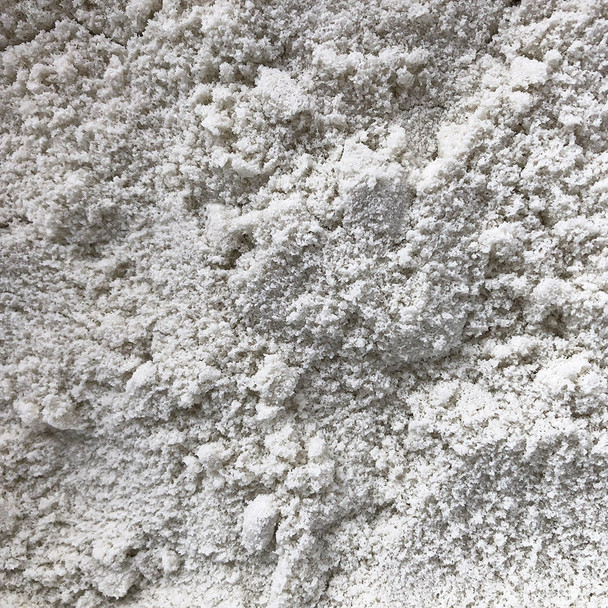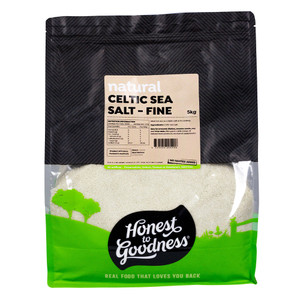Unlike heavily processed table salt, this Celtic Sea Salt is harvested using non-mechanised, human scale farmlands, allowing for the necessary time and care to be taken when cultivating this salt. This unwashed, unrefined, additive-free Celtic Sea Salt, retains its natural mineral content, making it a healthier and more wholesome choice for your wholefoods journey.
Both our coarse and fine Celtic Sea Salt are extracted from the saline marshlands in Le Guérande, Western France, hand-harvested using traditional methods and is well known for its culinary virtues. It is naturally grey as it crystallises on contact with the clay naturally found in the salt marshes. This colour is testament to its natural extraction and processing methods.
Compared to regular table salt, which is produced by high temperature processing and refining to reduce it to sodium chloride, naturally derived Celtic Sea Salt has a distinct flavour and texture. Its lightly sea-kissed flavour and singular texture contributes its mineral magic to any dish. Perfect for salting stocks, cooking vegetables, salting pasta water, barbequed/meat rubs and fish cooked with a salt crust.
Celtic Sea salt is less processed than other salts and is therefore known for its moist texture and light grey hue. Natural processing methods allow our Celtic Sea Salt to be abundant in trace minerals such as magnesium, calcium and potassium, making it an electrolyte trifecta for quality hydration.
Celtic Sea Salt texture can either be a fine grind or a coarse grind. The choice between fine and coarse Celtic Sea Salt depends on the specific culinary application and the texture you desire in your dishes. The nutritional profile of both salts is the same. More information can be found in the 'how to use' section.
NB: SEL FIN DE GUERANDE - NATURAL FINE SEA SALT is another name used for Celtic Sea Salt - Fine, this is the name used by the supplier and you may see this on some of the bulk packaging. Water flows from the Celtic Sea, into the Guérande peninsula (hence the name) where it is received by marshes. Marshes are a patchwork of ponds or various geometric shapes, which receive the salt enriched water and begin natural evaporation processes.
HOW TO USE
Honest to Goodness fine Celtic salt offers flavours ideal for traditional family cooking. Its lightly sea-kissed flavour and singular texture makes it perfect for salting stocks, cooking vegetables, salting pasta water, barbequed/meat rubs and fish cooked with a salt crust. Professional chefs favour it for finishing meals and presentation. A light sprinkle on meats, salads, vegetables, popcorn and caramel will provide an excellent flavour and crunch.
Celtic Sea Salt has the ideal texture to use when making flavoured salts. Combine it with dried herbs, citrus zests, and spices to create rubs, seasonings and flavoured salts. Store it in an airtight container.
The moist crystals of Celtic Sea Salt evenly distribute throughout dough when kneaded, to create a flakier texture. It works well in pizza dough, bread dough and pastry.
Celtic Sea salt adds depth and richness to soups and sauces. Stir it into stocks, broths, soups, curries, relishes and sauces.
The high-mineral Celtic Sea Salt coarse crystals can also be used to make an exfoliating body scrub. Pair the course salt with our Organic Virgin Coconut oil to create a revitalising exfoliating treatment. Remember, the skin is our largest organ, so it is important to treat it with care too!
Celtic Sea Salt - Fine vs Coarse
Are you wondering which one to use? Celtic Sea Salt texture can either be a fine grind or a coarse grind. The choice between fine and coarse Celtic sea salt depends on the specific culinary application and the texture you desire in your dishes.
Celtic Sea Salt - FINE
This salt has a finer texture as the name would suggest, and the crystals are smaller and more uniform. Due to its fine texture, it dissolves more quickly and evenly, making it ideal for times when you want the salt to blend seamlessly into your food or liquid, such as in baking, sauces, and dressings.
Celtic Sea Salt - COARSE
This salt has larger, irregularly shaped crystals. These crystals can vary in size and are more noticeable in dishes. This salt is ideal for applications where you want a bit of texture and a satisfying crunch, such as finishing a dish or adding texture to the surface of meats or vegetables.
Whichever one you choose...enjoy!
GROWING & PROCESSING
Although the name 'Celtic' might suggest this salt is from Ireland, it is not, it is actually French! Our Celtic Sea Salt is harvested from the Guérande peninsula in Western France, of which water from the Celtic Sea flows into the 2000 hectares of salt marshes.
Harvesting techniques are suited to this special environment, utilising high and low tides, and natural energy resources such as sun, wind and gravity. The non-mechanised, human scale farmlands allow for the necessary time and care to be taken when cultivating this salt. Tide from the sea flows into the salt marshes (ponds of varying geometric shapes) twice a day. Water flows through a series of channels, where unwanted particles and debris are naturally separated along the way.
Using a wooden rake, salt farmers manually collect the salt from the seawater and allow it to dry using the natural elements of the sun and wind. This is a slow process that eliminates the usual high-heat processing steps, enabling the raw, unrefined salt to retain its maximum mineral content.
INGREDIENTS
Celtic Sea Salt





Unlike heavily processed table salt, this Celtic Sea Salt is harvested using non-mechanised, human scale farmlands, allowing for the necessary time and care to be taken when cultivating this salt. This unwashed, unrefined, additive-free Celtic Sea Salt, retains its natural mineral content, making it a healthier and more wholesome choice for your wholefoods journey.
Both our coarse and fine Celtic Sea Salt are extracted from the saline marshlands in Le Guérande, Western France, hand-harvested using traditional methods and is well known for its culinary virtues. It is naturally grey as it crystallises on contact with the clay naturally found in the salt marshes. This colour is testament to its natural extraction and processing methods.
Compared to regular table salt, which is produced by high temperature processing and refining to reduce it to sodium chloride, naturally derived Celtic Sea Salt has a distinct flavour and texture. Its lightly sea-kissed flavour and singular texture contributes its mineral magic to any dish. Perfect for salting stocks, cooking vegetables, salting pasta water, barbequed/meat rubs and fish cooked with a salt crust.
Celtic Sea salt is less processed than other salts and is therefore known for its moist texture and light grey hue. Natural processing methods allow our Celtic Sea Salt to be abundant in trace minerals such as magnesium, calcium and potassium, making it an electrolyte trifecta for quality hydration.
Celtic Sea Salt texture can either be a fine grind or a coarse grind. The choice between fine and coarse Celtic Sea Salt depends on the specific culinary application and the texture you desire in your dishes. The nutritional profile of both salts is the same. More information can be found in the 'how to use' section.
NB: SEL FIN DE GUERANDE - NATURAL FINE SEA SALT is another name used for Celtic Sea Salt - Fine, this is the name used by the supplier and you may see this on some of the bulk packaging. Water flows from the Celtic Sea, into the Guérande peninsula (hence the name) where it is received by marshes. Marshes are a patchwork of ponds or various geometric shapes, which receive the salt enriched water and begin natural evaporation processes.
HOW TO USE
Honest to Goodness fine Celtic salt offers flavours ideal for traditional family cooking. Its lightly sea-kissed flavour and singular texture makes it perfect for salting stocks, cooking vegetables, salting pasta water, barbequed/meat rubs and fish cooked with a salt crust. Professional chefs favour it for finishing meals and presentation. A light sprinkle on meats, salads, vegetables, popcorn and caramel will provide an excellent flavour and crunch.
Celtic Sea Salt has the ideal texture to use when making flavoured salts. Combine it with dried herbs, citrus zests, and spices to create rubs, seasonings and flavoured salts. Store it in an airtight container.
The moist crystals of Celtic Sea Salt evenly distribute throughout dough when kneaded, to create a flakier texture. It works well in pizza dough, bread dough and pastry.
Celtic Sea salt adds depth and richness to soups and sauces. Stir it into stocks, broths, soups, curries, relishes and sauces.
The high-mineral Celtic Sea Salt coarse crystals can also be used to make an exfoliating body scrub. Pair the course salt with our Organic Virgin Coconut oil to create a revitalising exfoliating treatment. Remember, the skin is our largest organ, so it is important to treat it with care too!
Celtic Sea Salt - Fine vs Coarse
Are you wondering which one to use? Celtic Sea Salt texture can either be a fine grind or a coarse grind. The choice between fine and coarse Celtic sea salt depends on the specific culinary application and the texture you desire in your dishes.
Celtic Sea Salt - FINE
This salt has a finer texture as the name would suggest, and the crystals are smaller and more uniform. Due to its fine texture, it dissolves more quickly and evenly, making it ideal for times when you want the salt to blend seamlessly into your food or liquid, such as in baking, sauces, and dressings.
Celtic Sea Salt - COARSE
This salt has larger, irregularly shaped crystals. These crystals can vary in size and are more noticeable in dishes. This salt is ideal for applications where you want a bit of texture and a satisfying crunch, such as finishing a dish or adding texture to the surface of meats or vegetables.
Whichever one you choose...enjoy!
GROWING & PROCESSING
Although the name 'Celtic' might suggest this salt is from Ireland, it is not, it is actually French! Our Celtic Sea Salt is harvested from the Guérande peninsula in Western France, of which water from the Celtic Sea flows into the 2000 hectares of salt marshes.
Harvesting techniques are suited to this special environment, utilising high and low tides, and natural energy resources such as sun, wind and gravity. The non-mechanised, human scale farmlands allow for the necessary time and care to be taken when cultivating this salt. Tide from the sea flows into the salt marshes (ponds of varying geometric shapes) twice a day. Water flows through a series of channels, where unwanted particles and debris are naturally separated along the way.
Using a wooden rake, salt farmers manually collect the salt from the seawater and allow it to dry using the natural elements of the sun and wind. This is a slow process that eliminates the usual high-heat processing steps, enabling the raw, unrefined salt to retain its maximum mineral content.
INGREDIENTS
Celtic Sea Salt















